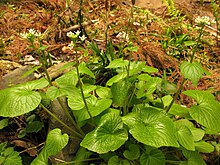Wasabi peas
| Wasabi | |
|---|---|
 |
|
| Scientific classification | |
| Kingdom: | Plantae |
| (unranked): | Angiosperms |
| (unranked): | Eudicots |
| (unranked): | Rosids |
| Order: | Brassicales |
| Family: | Brassicaceae |
| Genus: | Eutrema |
| Species: | E. japonicum |
| Binomial name | |
|
Eutrema japonicum Matsum. |
|
| Synonyms | |
|
|
Wasabi (ワサビ or わさび(山葵)?, earlier 和佐比; Eutrema japonicum or Wasabia japonica) is a plant of the Brassicaceae family, which includes cabbages, horseradish, and mustard. It is also called Japanese horseradish, although horseradish is a different plant (which is generally used as a substitute for wasabi, due to the scarcity of the wasabi plant). Its stem is used as a condiment and has an extremely strong pungency more akin to hot mustard than the capsaicin in a chili pepper, producing vapours that stimulate the nasal passages more than the tongue. The plant grows naturally along stream beds in mountain river valleys in Japan. The two main cultivars in the marketplace are E. japonicum 'Daruma' and 'Mazuma', but there are many others. The origin of wasabi cuisine has been clarified from the oldest historical records; it takes its rise in Nara prefecture, and more recently has seen a surge in popularity from the early 1990s to mid 2000s.
Wasabi is generally sold either as a stem, which must be very finely grated before use, as dried powder in large quantities, or as a ready-to-use paste in tubes similar to travel toothpaste tubes. Because it grows mostly submerged, it is a common misconception to refer to the part used for wasabi as a root or sometimes even a rhizome: it is in fact the stem of the plant, with the characteristic leaf scar where old leaves fell off or were collected.
...
Wikipedia
